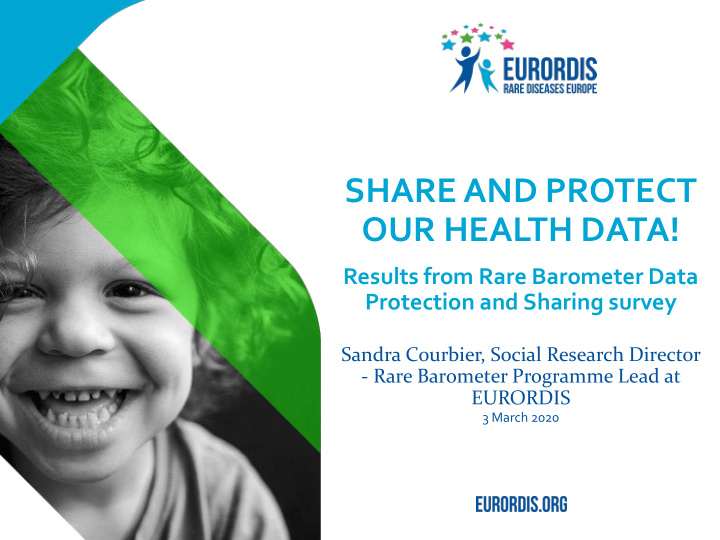



SHARE AND PROTECT OUR HEALTH DATA! Results from Rare Barometer Data Protection and Sharing survey Sandra Courbier, Social Research Director - Rare Barometer Programme Lead at EURORDIS 3 March 2020 Classified as public by the European Medicines Agency
Webinar + follow up discussion on concerns of Quantitative survey on Patient Advisory GDPR, 50 participants, 2017 rare disease patients Council (PAC) (16 participation in members), 2012- research (3213 2018 patients), 2017 Multiple approaches to securing patient preferences on Focus groups on rare data sharing diseases patients perspectives on use and sharing of genomic data Delphi exercise with expert patients on data sharing and data (22 patients), 2017 protection (16 patients), 2016) Participation in focus groups on data sharing for international research (52 patients) ‘You should at least ask’ (McCormack P1, Kole A, 2016) 2 Classified as public by the European Medicines Agency
Rare Disease population specificities Project goal Encourage researchers and healthcare stakeholders in charge of or participating in data-sharing initiatives to recognise the importance of understanding rare disease patient perspectives Encourage discussion about data sharing best practices 3 Classified as public by the European Medicines Agency
First large scale, multi-country survey on data sharing Translated Fieldwork Accessible to a 2013 into 23 from March diverse respondents population languages to May 2018 Target population : patients living with a rare disease or family members (parents and close relatives) of over 16 years old Questionnaire designed : Topic expert Committee, sociology, legal, computational biology, rare disease patient advocacy, ethics, patient reported outcome measurement 66 countries and 664 diseases represented 4 Classified as public by the European Medicines Agency
Rare disease patients are clearly willing to share their data 5 Classified as public by the European Medicines Agency
They also support data sharing for wider scientific interest 6 Classified as public by the European Medicines Agency
Patients want to have control over the data they are sharing 7 Classified as public by the European Medicines Agency
Top three incentives encouraging participation 8 Classified as public by the European Medicines Agency
Top four risks associated with sharing data 9 Classified as public by the European Medicines Agency
Higher levels of confidence in not-for-profit stakeholders 10 Classified as public by the European Medicines Agency
Top three most important pieces of information 11 Classified as public by the European Medicines Agency
Opinions are fragmented on whether responsibility could be delegated to ethic committee 12 Classified as public by the European Medicines Agency
Email and face-to-face discussion favoured ways of receiving information 13 Classified as public by the European Medicines Agency
The ideal frequency to be informed for a majority of respondents is once a month 14 Classified as public by the European Medicines Agency
Recommendations . . . . Ensure implementation of appropriate legislation Policy makers should ensure implementation of appropriate legislations at European and national levels and pursue efforts to foster cultural, technological and infrastructural changes to further develop international data sharing initiatives in health and research for rare diseases. & Include trusted representatives and implement robust safeguards Governing structures of data-sharing initiatives should: Develop and implement robust standards to ensure secure, ethical and responsible data sharing whilst putting in place safeguards around data protection Include representatives from trusted advocacy organisations, i.e. patient organisations and non-profit organisations as well as clinicians and healthcare professionals 15 Classified as public by the European Medicines Agency
Recommendations . . . . Promote dynamic systems All stakeholders involved in data sharing initiatives need to promote the development of, and implement, dynamic systems enabling: The possibility to express different attitudes and preferences Access to updated information on research outcomes to increase patient participation in research and stimulate data sharing whilst respecting patients’ preferences Dedicate finance to educational resources All stakeholders involved in data sharing initiatives including healthcare systems and other relevant authorities should allocate resources at national and regional levels to enable the development of, and facilitate access to, relevant educational resources to enable informed choices for patients to share or not to share their health-related data. 16 Classified as public by the European Medicines Agency
Recommendations . . . . Dedicate finance to educational resources Funders and sponsors of data sharing activities should ensure that adequate financial resources are allocated to improve communication and increase transparency on the purpose and outcomes of data sharing initiatives to maximise the benefits of the project outcomes. Emphasise potential health benefits of studies Funders, clinicians and researchers need to emphasise potential health benefits of research studies and healthcare initiatives on future generations and other disease areas, as an incentive for wider participation in data sharing initiatives. 17 Classified as public by the European Medicines Agency
Data survey outcomes Peer-reviewed publication Share and protect our health data An evidence based approach to rare disease patients’ perspectives on data sharing and data protection - Quantitative survey and recommendations Sandra Courbier, Rebecca Dimond, Virginie Bros-Facer EURORDIS-Rare Diseases Europe, Paris, France School of Social Sciences, Cardiff University, Cardiff, UK Published in Orphanet Journal of Rare Diseases , 12 July 2019 Available online at: https://doi.org/10.1186/s13023-019-1123-4 Graphic report 18 Classified as public by the European Medicines Agency
Thank you to all Rare Barometer partners: This project is co-funded by the European Union Call for Proposals VP/2014/008; EaSI PROGRESS, www.eurordis.org/voices DG Employment, Social Affairs and Inclusion Classified as public by the European Medicines Agency
Recommend
More recommend